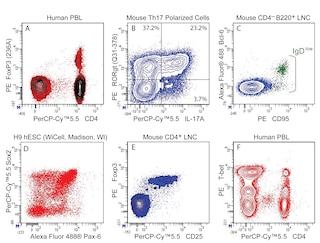Old Browser
This page has been recently translated and is available in French now.
Looks like you're visiting us from {countryName}.
Would you like to stay on the current country site or be switched to your country?




Multicolor flow cytometric analysis of RORγt expression in mouse thymocytes. BALB/c mouse thymocytes were stained with FITC Rat Anti-Mouse CD4 (Cat. No. 553047/553046/561835) and PE Rat Anti-Mouse CD8a (Cat. No. 553033/553032/561095) antibodies, and then fixed and permeabilized using the BD Pharmingen™ Transcription Factor Buffer Set (Cat. No. 562574/562725). The fixed and permeabilized cells were then stained with either Alexa Fluor® 647 Mouse IgG2a, κ Isotype Control (Cat. No. 557715) or Alexa Fluor® 647 Mouse Anti-Mouse RORγt antibody (Cat. No. 562682). The overlapping histograms show the levels of IgG2a Isotype Control (Left Panel) and RORγt (Right Panel) staining in CD4+ CD8- single-positive (dashed line histogram) or CD4+ CD8+ double-positive (solid line histogram) thymocytes. The fluorescence histograms were derived from events with the forward and side light-scatter characteristics of intact cells. Flow cytometry was performed using a BD™ LSR II Flow Cytometry System.


BD Pharmingen™ Alexa Fluor® 647 Mouse Anti-Mouse RORγt

Regulatory Status Legend
Any use of products other than the permitted use without the express written authorization of Becton, Dickinson and Company is strictly prohibited.
Preparation And Storage
Recommended Assay Procedures
Optimal staining occurs when using the BD Pharmingen™ Alexa Fluor® 647 Mouse anti-Mouse RORγt antibody with cells that have been fixed and permeabilized with the BD Pharmingen™ Transcription Factor Buffer Set (Cat. No. 562574/562725).
Product Notices
- Since applications vary, each investigator should titrate the reagent to obtain optimal results.
- An isotype control should be used at the same concentration as the antibody of interest.
- Please refer to www.bdbiosciences.com/us/s/resources for technical protocols.
- The Alexa Fluor®, Pacific Blue™, and Cascade Blue® dye antibody conjugates in this product are sold under license from Molecular Probes, Inc. for research use only, excluding use in combination with microarrays, or as analyte specific reagents. The Alexa Fluor® dyes (except for Alexa Fluor® 430), Pacific Blue™ dye, and Cascade Blue® dye are covered by pending and issued patents.
- Alexa Fluor® is a registered trademark of Molecular Probes, Inc., Eugene, OR.
- Alexa Fluor® 647 fluorochrome emission is collected at the same instrument settings as for allophycocyanin (APC).
- Caution: Sodium azide yields highly toxic hydrazoic acid under acidic conditions. Dilute azide compounds in running water before discarding to avoid accumulation of potentially explosive deposits in plumbing.
- For fluorochrome spectra and suitable instrument settings, please refer to our Multicolor Flow Cytometry web page at www.bdbiosciences.com/colors.
Companion Products






The Q31-378 monoclonal antibody recognizes mouse RORgamma t (RORγt), an isoform of RORgamma (RORγ). RORγt is a DNA-binding transcription factor that belongs to the ROR/RZR orphan nuclear receptor family. RORγt is expressed exclusively by lymphoid cells including CD4+CD8+ thymocytes, peripheral CD4+ Th17 and CD8+ Tc17 cells, NKT cells and innate lymphoid cells such as lymphoid tissue inducer (LTi) cells. RORγt plays essential roles in thymopoiesis, T cell homeostasis, differentiation of effector T lymphocytes and the development of secondary lymphoid tissues including lymph nodes and Peyer's patches.
Development References (9)
-
Bechtel S, Rosenfelder H, Duda A, et al. The full-ORF clone resource of the German cDNA Consortium. BMC Biochem. 2007; 8:399-410. (Biology). View Reference
-
Eberl G, Littman DR. The role of the nuclear hormone receptor RORgt in the development of lymph nodes and Peyer's patches. Immunol Rev. 2003; 195(195):81-90. (Biology). View Reference
-
Eberl G, Marmon S, Sunshine MJ, Rennert PD, Choi Y, Littman DR. An essential function for the nuclear receptor RORgamma(t) in the generation of fetal lymphoid tissue inducer cells. Nat Immunol. 2004; 5(1):64-73. (Biology). View Reference
-
Hamada H, Garcia-Hernandez MdlL, Reome JB, et al. Tc17, a unique subset of CD8 T cells that can protect against lethal influenza challenge. J Immunol. 2009; 182(6):3469-3481. (Biology). View Reference
-
He YW, Deftos ML, Ojala EW, Bevan MJ. RORgamma t, a novel isoform of an orphan receptor, negatively regulates Fas ligand expression and IL-2 production in T cells. Immunity. 1998; 9(6):797-806. (Biology). View Reference
-
Hirose T, Smith RJ, Jetten AM. ROR gamma: the third member of ROR/RZR orphan receptor subfamily that is highly expressed in skeletal muscle. Biochim Biophys Acta. 1994; 205(3):1976-1983. (Biology). View Reference
-
Ivanov, II, McKenzie BS, Zhou L, et al. The orphan nuclear receptor RORgammat directs the differentiation program of proinflammatory IL-17+ T helper cells. Cell. 2006; 126(6):1121-1133. (Biology). View Reference
-
Medvedev A, Yan ZH, Hirose T, Giguere V, Jetten AM. Cloning of a cDNA encoding the murine orphan receptor RZR/ROR gamma and characterization of its response element. Gene. 1996; 181(1-2):199-206. (Biology). View Reference
-
Unutmaz D. RORC2: the master of human Th17 cell programming. Eur J Immunol. 2009; 39(6):1452-1455. (Biology). View Reference
Please refer to Support Documents for Quality Certificates
Global - Refer to manufacturer's instructions for use and related User Manuals and Technical data sheets before using this products as described
Comparisons, where applicable, are made against older BD Technology, manual methods or are general performance claims. Comparisons are not made against non-BD technologies, unless otherwise noted.
For Research Use Only. Not for use in diagnostic or therapeutic procedures.
Report a Site Issue
This form is intended to help us improve our website experience. For other support, please visit our Contact Us page.